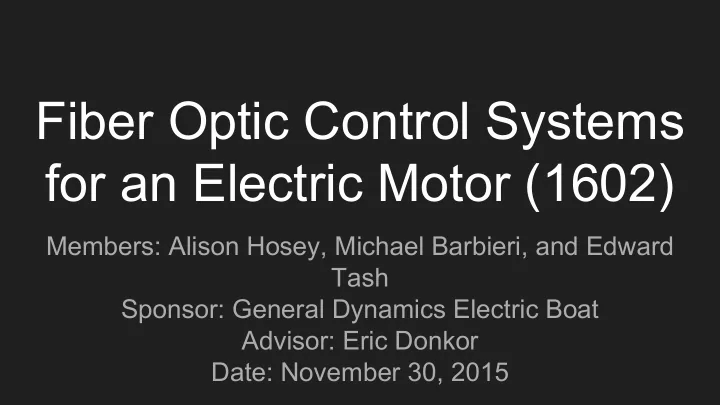

Fiber Optic Control Systems for an Electric Motor (1602) Members: Alison Hosey, Michael Barbieri, and Edward Tash Sponsor: General Dynamics Electric Boat Advisor: Eric Donkor Date: November 30, 2015
Overview Introduction ➢ ○ General Project Overview ■ Technology Description ■ Project Overview ■ Project Plan ■ Benefits of Implementing Technology Background ➢ ○ How fiber optics work ○ Benefits of fiber optics vs. their copper counterpart ➢ Optical Chopper ○ What it is ○ How does it relate to our project Basic Ideas ➢ ○ What we have done, are currently doing, and plan to do Important Items ➢ ➢ Timeline Conclusion ➢
Introduction
Background Fiber optic cable construction - Figure 1 ➢ ➢ Modes of operation ○ Single mode fiber vs. multi mode fiber - Figure 2 Multiplexing ➢ Figure 1- Five components Figure 2- Light propagation paths within ○ Wavelength division multiplexing - that make up a fiber optic single mode fiber as well as multimode fiber. cable. Figure 3 Power over Fiber (PoF) ➢ ○ Allows for power to be transmitted over light Media converter ➢ ○ Converts copper signals to light signals Figure 3- Signals of different wavelengths are multiplexed together over a single fiber optic cable and then demultiplexed and output accordingly. ○ Converts light signals to copper signals
Background (cont.) Fiber Optics vs. Copper: Resistant to Electromagnetic Interference (EMI) ➢ ○ Fiber optic cables and components will not disrupt the operation of another electronic device in its vicinity as fiber does not give off any electromagnetic field. ➢ Data is transferred 10x faster ○ Fiber transfers data at approximately 10 Gigabits/sec where copper transfers data at approximately 1 Gigabit/sec. Does not give off heat/ is non-flammable ➢ ○ Fiber does not pass electricity. Security ➢ ○ Fiber is almost impossible to tap where copper is very susceptible to being tapped Size/ Weight ➢ ○ Fiber is approximately 0.9 micrometers in diameter and weighs approximately 0.0235 pounds/ft.
Optical Chopper System ➢ ○ Stanford Research Systems ○ SR540 ➢ Purpose ○ Optical Experimentation ○ DC motor power ○ Chopping frequency control Capabilities ➢ ○ Adjustable frequency (from 4Hz to 3.7kHz ) ○ Input control voltage
Optical Chopper (cont.) Project Testbed ➢ ○ Analyze Non-Optical Circuitry ○ Change to Optic-Based System ■ Original power to PoF ■ Motor control circuit to fiber equivalent signals ○ Implement Cohesive Fiber System Open Source Design ➢ ○ Full Parts List ○ PCB layout ○ System Schematic
Basic Idea ● Multiplexing signals and power source through one coupler ● One Fiberlink cable to be connected between the coupler and the DeMUX ● Use of DeMUX to split off contacts to the power source and signals ● Power over Fiber source to be a 24V source ● Signal Controls to the sensor need for ○ Temperature, Rotor Positioning, Measurements
Basic Idea
Backing up ideas ● Using the Optical Chopper to test if hypothesis is correct ● Taking signals from Optical Chopper (4 signals) ● The testing process will be using the basic idea ● Using the optical chopper data signal and power signals ● Coupling the power and signal ● One fiber link ● DeMUX to branch the power and data to the output
Important Items ● Infrared LED’s ○ 645 nm-660 nm red ○ three different having different wavelengths ○ issues with longer distances (chromatic Dispersion) ● IR laser ○ different wavelengths for different signals ○ easier to multiplex and and deMUX back to original signals ○ no issues over longer distances ● Multiplexer ○ need multiplex with power signal ○ one 850nm line, multiple 1550nm lines ○ possible media conversions required
Timeline Investigate Fiber Optic Instrumentation ❏ 10/16/15 Research Commercially Available PoF Equipment ❏ 11/20/15 Design PoF system for DC motor ❏ 12/11/15 Integrate Optical Instrumentation and PoF technology ❏ 2/15/16 Test Motor + Optical Hardware Performance ❏ 4/1/16 ( document results and recommendations )
Conclusion Benefits of Fiber Optics ➢ ○ Technical Capability (EMI, speed, heat) ○ Cost Saving ○ Scheduling Advantages Optical Chopper ➢ ○ Circuit Analysis ○ PoF + Optical Motor Control Testbed Single Fiber Link Design ➢ ○ Coupled Power and Control Signals ○ Commercially-available Hardware
Recommend
More recommend